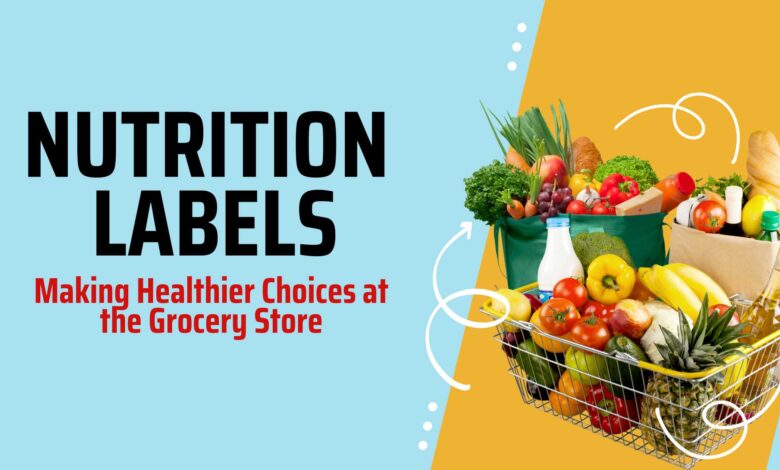Navigating Nutrition Labels: Making Healthier Choices at the Grocery Store

In today’s fast-paced world, navigating the grocery store aisles can be overwhelming. With so many processed and packaged foods vying for our attention, it can be difficult to make the right decision about what to include in your shopping basket. Nutrition labels play an important role in helping us interpret the nutritional content of packaged foods, but understanding and interpreting this information requires knowledge. This article takes an in-depth look at the key components of food labels, empowers you to analyze the information accurately, and provides practical strategies for choosing healthy options at the grocery store.
Table of Contents
Avoid Food Labels: The Impact
Food labels, regulated by the US Food and Drug Administration (FDA), are a valuable resource for consumers. The following are important areas to focus on:
- Portion size: This is the most overlooked factor, but it is the basis for explaining the following information. Please note that the serving sizes shown may not reflect how much you are consuming.
- Calories: This is an indication of the total number of calories per meal. Although calories are important for energy, focusing only on the number of calories can be misleading.
- Daily Value (DV): The percentage next to each nutrient indicates how much of the nutrient’s intake is equivalent to a standard 2,000 calorie diet. This will help you know if you are eating too much or too little of certain nutrients.
- Food List: This section lists the foods in order of quantity. The ingredients listed first are mostly the product. Look for products that list whole foods that have not been processed first.
Beyond the Basics: Key Education Label Ideas
While the basic ingredients of a healthy food label are a foundation, there are other things to consider when making the right choice:
- Added Sugar: Beware of added sugar, which produces unnecessary calories that can be harmful to health. Focus on products with less added sugar.
- Fiber: Fiber plays an important role in digestion and increases feelings of fullness. Increase foods rich in dietary fiber.
- Process vs. Processed foods Whole foods: In general, whole, unprocessed foods are better choices than processed foods. Look for products with shorter, simpler input lists.
- Hidden Sugars: Watch out for hidden sugars hiding in unexpected places, such as salad dressings, snacks and healthy snacks. Read ingredient lists carefully to find hidden sources of sugar.
- Fraudulent serving sizes: Manufacturers sometimes use fraudulent serving sizes. Compare the serving size on the label with how much you are eating.
- Changes to Your Shopping Cart: Strategies for Healthy Choices
By knowing food labels, you can turn this knowledge into action:
- Planning is key: Prepare your shopping list before going to the store. This helps to make healthy choices and avoid impulse purchases.
- Fruit Strengths: Focus on the perimeter of your grocery store, where you’ll find fresh fruit, lean protein sources, and dairy products.
- Always read labels: Don’t rely solely on branding or marketing claims. Be sure to read the label of every product you consider buying.
- Compare and Contrast: Compare similar products in a category to decide which product is the best to eat. Don’t be afraid of fats: Healthy fats, such as nuts, seeds, and avocados, are an important part of a balanced diet. Choose healthy fats over processed fat sources.
- Focus on whole foods: Choose natural, unprocessed foods such as fruits, vegetables, whole grains, and lean protein sources.
- Beware of marketing: Don’t be fooled by health claims on the packaging. Read food labels carefully to get the whole picture. Think long term: Building a healthy eating habit is a marathon, not a sprint. The goal is to make gradual changes and focus on making healthy choices over time.
- Embrace variety: Explore all kinds of fruits, vegetables, and grains to make sure you’re getting a variety of nutrients.
- Don’t be afraid to freeze or freeze: Frozen and canned fruits and vegetables are easy and affordable. Choose fruits with very little added sugar or sodium. Stock up on healthy foods: Stocking up on healthy foods like brown rice, quinoa, lentils, beans, and frozen vegetables makes it easier to prepare healthy meals at home.
- Cooking at home: Cooking at home allows you to control food and portion sizes, thus encouraging better eating habits.
- Get guidance when you need it: If you have special dietary needs or concerns, see a registered dietitian or nutritionist for personal guidance.
The power of choosing wisely
Knowing food labels can help you make better choices at the grocery store. By focusing on natural, unprocessed foods, choosing fruits, vegetables, and whole grains, and limiting processed foods high in added sugar, unhealthy fats, and sodium, you can You navigate the grocery store with confidence and lay the foundation for a healthy eating pattern. . Remember, small changes to a balanced diet can have a big impact on your health.
The future of food labeling: transparency and innovation
The food labeling landscape is still evolving. Here are some interesting trends shaping the future:
Simplify labels: There is a growing movement to simplify food labels to make them easier to understand for consumers. Attention to added sugars: Attention to added sugars in products is being investigated.
Transparency: Consumers are demanding more transparency about the origin and processing methods of food.
New technologies: Technology such as QR codes on packaging can provide more information about the nutrition and origin of a product.
By staying up-to-date on food label developments, you can continue to make informed choices and support greater awareness in the food industry.
Also Read:Arthritis Management and Prevention-No1
Conclusion
Navigating the food labeling world is not a difficult task. By equipping yourself with the necessary knowledge and implementing practical strategies, you can transform your shopping experience. Remember, choosing natural and unprocessed foods, reading labels critically, and developing a thoughtful approach to food choices can help you take responsibility for your health and well-being. With every smart decision you make at the grocery store, you’re investing in a healthier, more sustainable lifestyle.




